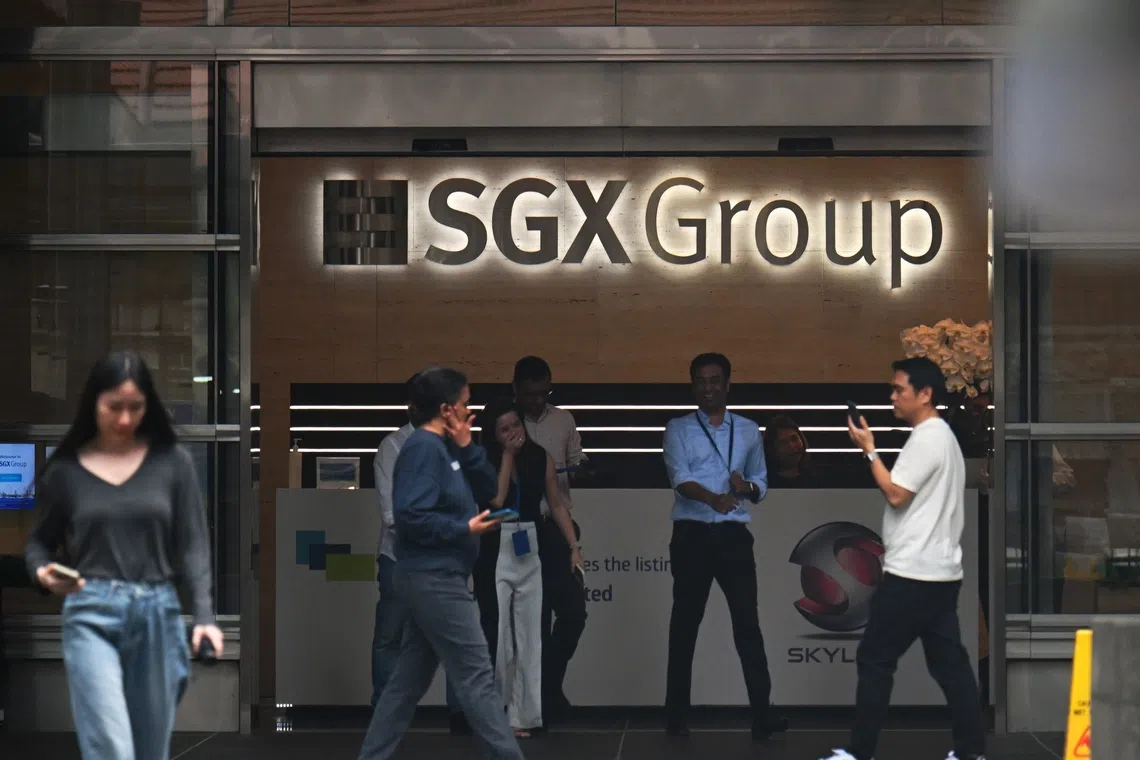Retail investors trading more intensively in new listings: SGX CEO
Sign up now: Get ST's newsletters delivered to your inbox

There were nine new listings in the quarter, raising over $2.2 billion.
ST PHOTO: KUA CHEE SIONG
Follow topic:
SINGAPORE – A flurry of retail investor activity has greeted new listings on the Singapore Exchange (SGX) from July, as efforts to revitalise the local bourse appear to have turned a corner.
Retail participation on the SGX reached a three-year high, with the positive trajectory continuing into the first quarter of the 2026 financial year, said SGX Group chief executive Loh Boon Chye on Oct 9.
There were nine new listings in the quarter, raising over $2.2 billion.
“Retail participation in our new listings has trended above the market average, which shows the growing traction and interest that our new listings are generating among retail investors.”
Mr Loh was speaking at the 26th annual general meeting (AGM) of the group at Marina Bay Sands Expo and Convention Centre, which over 300 shareholders turned up for.
In the first quarter, the highest growth was observed in the small- and mid-cap counters, with securities daily average value more than doubling from the same time a year ago, which Mr Loh said reflects broader market participation.
He said the group expects more listings for the rest of 2025, noting that four companies had announced their plans to list in the past two weeks.
He noted that securities daily average value on the SGX grew the most in Asean, with turnover up 27 per cent year on year, in the 2025 financial year.
Mr Loh also reiterated a target of 6 per cent to 8 per cent compounded annual growth rate in revenue, excluding treasury income, over the medium term.
The group, he said, has three strategic areas of focus – scaling its foreign exchange business, broadening and deepening its derivatives franchise, and accelerating the growth of its securities business.
“As the only international and neutral venue offering liquid access to commodities, currencies and equities, we offer clients a holistic risk view,” he said.
Cross-selling has gained strong traction, he noted, with 6 per cent of direct trading accounts having added at least one more asset in the 2025 financial year.
The group also plans to increase dividends paid out by 0.25 cent every quarter until the 2028 financial year.
SGX Group will pay out a final quarterly dividend of 10.5 cents for the financial year ended June 30, 2025 – 1.5 cents more than for the same period a year ago.
This brings the full-year dividend to 37.5 cents, on the back of record turnover and net profit numbers, which a large majority of shareholders approved at the AGM.
A closed-door question-and-answer session open to only shareholders or their proxies was held before the meeting.
They could also pose questions to the board at the meeting itself.
Most of the questions asked there revolved around compensation – both for top executives and that proposed for the board – as well as the board’s view on potential opportunities including new stock indexes, cryptocurrency trading, and greater integration with bourses elsewhere.
One shareholder asked how the board would tap technology to ensure growth meets the higher expectations that come with strong share performance.
To this, board chairman Koh Boon Hwee said there are ongoing efforts to refresh the technology used by the group, noting that artificial intelligence is not something foreign to the group.
“The low-hanging fruit is using it for some of our internal processes, for activities like surveillance, but it is something that we will continue to concentrate on,” he added.
Responding to questions on executive compensation, Mr Lim Chin Hu, board member and chairman of the remuneration and staff development committee, set out the committee’s approach in setting pay.
This involves looking at the salaries drawn by senior management across 13 stock exchanges worldwide – such as those in Australia and Japan – that SGX compares itself against.
“We also look at, as a reality check, listed companies in Singapore,” Mr Lim added.
He noted that Mr Loh’s total compensation increased by 3 per cent, much less than the earnings growth.
The group’s adjusted net profit after tax reached $610 million for the 2025 financial year, up by almost 16 per cent.
Another shareholder asked about the possibility of developing indexes of companies with high returns on invested capital, dividend yields or total shareholder returns, beyond using market capitalisation.
He said this would ensure the efforts to boost liquidity and revitalise the equity market here are more widely spread, thereby ensuring more resilient and sustained growth.
SGX recently launched two indexes
Mr Koh said in response that these “thematic indices” are something the group can study, thanking the shareholder for the suggestion. However, he cautioned that the exchange is a platform that does not in itself create demand or supply, though the Government’s efforts to make Singapore a more vibrant capital market give cause for confidence.
On cryptocurrencies, Mr Koh said it is something the group is monitoring, but that it believes there are a lot of opportunities in the existing asset classes that the group is pursuing.
During the AGM, Mr Lim, Mr Loh and Ms Julie Gao, chief financial officer of ByteDance, were re-elected as directors.
The shareholders present also voted to elect Ms Susan Soh, co-CEO of Avanda Investment Management, as a director, replacing Ms Chng Sok Hui, DBS Group chief financial officer, who decided not to seek re-election.


